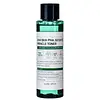What's inside
What's inside
 Key Ingredients
Key Ingredients

 Benefits
Benefits

 Concerns
Concerns

 Ingredients Side-by-side
Ingredients Side-by-side

Water
Skin ConditioningButylene Glycol
HumectantDipropylene Glycol
HumectantGlycerin
HumectantNiacinamide
SmoothingMelaleuca Alternifolia Leaf Water
AntimicrobialPolyglyceryl-4 Caprate
EmulsifyingCarica Papaya Fruit Extract
Skin ConditioningLens Esculenta Seed Extract
Skin ProtectingHamamelis Virginiana Extract
AntiseborrhoeicNelumbo Nucifera Flower Extract
Skin ConditioningSwiftlet Nest Extract
Skin ConditioningSodium Hyaluronate
HumectantFructan
Skin ConditioningAllantoin
Skin ConditioningAdenosine
Skin ConditioningHydroxyethyl Urea
HumectantXylitol
HumectantSalicylic Acid
MaskingLactobionic Acid
BufferingCitric Acid
BufferingSodium Citrate
Buffering1,2-Hexanediol
Skin ConditioningBenzyl Glycol
SolventEthylhexylglycerin
Skin ConditioningRaspberry Ketone
MaskingMentha Piperita Oil
MaskingWater, Butylene Glycol, Dipropylene Glycol, Glycerin, Niacinamide, Melaleuca Alternifolia Leaf Water, Polyglyceryl-4 Caprate, Carica Papaya Fruit Extract, Lens Esculenta Seed Extract, Hamamelis Virginiana Extract, Nelumbo Nucifera Flower Extract, Swiftlet Nest Extract, Sodium Hyaluronate, Fructan, Allantoin, Adenosine, Hydroxyethyl Urea, Xylitol, Salicylic Acid, Lactobionic Acid, Citric Acid, Sodium Citrate, 1,2-Hexanediol, Benzyl Glycol, Ethylhexylglycerin, Raspberry Ketone, Mentha Piperita Oil
Water
Skin ConditioningCitrus Limon Fruit Extract
MaskingGlycolic Acid
BufferingMethylpropanediol
SolventAlcohol Denat.
AntimicrobialSodium Hydroxide
BufferingDipropylene Glycol
HumectantSphingomonas Ferment Extract
Skin ConditioningCitrus Limon Peel Oil
MaskingSodium Hyaluronate
HumectantOzothamnus Diosmifolius Extract
Citrus Aurantium Dulcis Peel Oil
MaskingCitrus Aurantifolia Oil
CleansingRose Flower Oil
MaskingFortunella Margarita Peel Oil
Lavandula Angustifolia Oil
MaskingRosmarinus Officinalis Leaf Oil
MaskingAlthaea Rosea Flower Extract
Skin ConditioningCitrus Aurantium Bergamia Fruit Oil
Masking1,2-Hexanediol
Skin ConditioningOctyldodeceth-16
EmulsifyingPhosphorus Pentoxide
BufferingPanthenol
Skin ConditioningButylene Glycol
HumectantSalicylic Acid
MaskingAllantoin
Skin ConditioningPentylene Glycol
Skin ConditioningBeta-Glucan
Skin ConditioningCaprylyl Glycol
EmollientEthylhexylglycerin
Skin ConditioningPhenoxyethanol
PreservativeLimonene
PerfumingCitral
PerfumingWater, Citrus Limon Fruit Extract, Glycolic Acid, Methylpropanediol, Alcohol Denat., Sodium Hydroxide, Dipropylene Glycol, Sphingomonas Ferment Extract, Citrus Limon Peel Oil, Sodium Hyaluronate, Ozothamnus Diosmifolius Extract, Citrus Aurantium Dulcis Peel Oil, Citrus Aurantifolia Oil, Rose Flower Oil, Fortunella Margarita Peel Oil, Lavandula Angustifolia Oil, Rosmarinus Officinalis Leaf Oil, Althaea Rosea Flower Extract, Citrus Aurantium Bergamia Fruit Oil, 1,2-Hexanediol, Octyldodeceth-16, Phosphorus Pentoxide, Panthenol, Butylene Glycol, Salicylic Acid, Allantoin, Pentylene Glycol, Beta-Glucan, Caprylyl Glycol, Ethylhexylglycerin, Phenoxyethanol, Limonene, Citral
 Reviews
Reviews

Ingredients Explained
These ingredients are found in both products.
Ingredients higher up in an ingredient list are typically present in a larger amount.
1,2-Hexanediol is a synthetic liquid and another multi-functional powerhouse.
It is a:
- Humectant, drawing moisture into the skin
- Emollient, helping to soften skin
- Solvent, dispersing and stabilizing formulas
- Preservative booster, enhancing the antimicrobial activity of other preservatives
Allantoin is a soothing ingredient known for its protective and moisturizingg properties. Because of this, it is often added to products with strong active ingredients.
Studies show higher concentrations of this ingredient can promote wound healing.
Though it can be derived from the comfrey plant, allantoin is produced synthetically for cosmetic products to ensure purity.
Learn more about AllantoinButylene Glycol (or BG) is used within cosmetic products for a few different reasons:
Overall, Butylene Glycol is a safe and well-rounded ingredient that works well with other ingredients.
Though this ingredient works well with most skin types, some people with sensitive skin may experience a reaction such as allergic rashes, closed comedones, or itchiness.
Learn more about Butylene GlycolDipropylene Glycol is a synthetically created humectant, stabilizer, and solvent.
This ingredient helps:
Dipropylene glycol is technically an alcohol, but it belongs to the glycol family (often considered part of the ‘good’ alcohols). This means it is hydrating and gentle on skin unlike drying solvent alcohols like denatured alcohol.
As a masking agent, Dipropylene Glycol can be used to cover the smell of other ingredients. However, it does not have a scent.
Studies show Dipropylene Glycol is considered safe to use in skincare.
Learn more about Dipropylene GlycolEthylhexylglycerin (we can't pronounce this either) is commonly used as a preservative and skin softener. It is derived from glyceryl.
You might see Ethylhexylglycerin often paired with other preservatives such as phenoxyethanol. Ethylhexylglycerin has been found to increase the effectiveness of these other preservatives.
Salicylic Acid (also known as beta hydroxy acid or BHA) is a well-known ingredient for treating skin that struggles with acne and clogged pores. It exfoliates both the skin's surface and deep within the pores to help clear out buildup, control oil, and reduce inflammation.
Unlike AHAs (alpha hydroxy acids), salicylic acid is oil-soluble. This allows it to penetrate into pores which makes it especially effective for treating blackheads and preventing future breakouts.
Salicylic acid is also known for its soothing properties. It has a similar structure to aspirin and can calm inflamed or irritated skin, making it a good option for acne-prone skin that is also sensitive.
Concentrations of 0.5-2% are recognized by the U.S. FDA as an over-the-counter topical acne product.
It can cause irritation and/or dryness if one's skin already has a compromised moisture barrier, so it's best to focus on repairing that before introducing this ingredient into your routine.
While salicylic acid does not increase sun sensitivity, it’s still important to wear sunscreen daily to protect your skin.
If you are looking for the ingredient called BHA or Butylated Hydroxyanisole, click here.
Learn more about Salicylic AcidSodium Hyaluronate is hyaluronic acid's salt form. It is commonly derived from the sodium salt of hyaluronic acid.
Like hyaluronic acid, it is great at holding water and acts as a humectant. This makes it a great skin hydrating ingredient.
Sodium Hyaluronate is naturally occurring in our bodies and is mostly found in eye fluid and joints.
These are some other common types of Hyaluronic Acid:
Learn more about Sodium HyaluronateWater. It's the most common cosmetic ingredient of all. You'll usually see it at the top of ingredient lists, meaning that it makes up the largest part of the product.
So why is it so popular? Water most often acts as a solvent - this means that it helps dissolve other ingredients into the formulation.
You'll also recognize water as that liquid we all need to stay alive. If you see this, drink a glass of water. Stay hydrated!
Learn more about Water